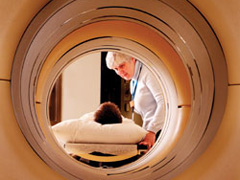PET Significantly Enhances Standard Imaging in Lung Cancer Staging
Positron emission tomography (PET) is a useful diagnostic tool that supports the need for more accurate staging of lung cancer and improved treatment for patients, concludes an extensive systematic review published online today in Journal of National Cancer Institute.
The review conducted by the Lung Cancer Disease Site Group of Cancer Care Ontario’s Program in Evidence-Based Care led by a Sunnybrook researcher, Dr. Yee Ung, evaluates the accuracy and utility of 18-fluorodeoxyglucose PET (18FDG-PET) in the diagnosis and staging of lung cancer.
“Lung cancer remains the leading cause of cancer-related death and early diagnosis provides the best chance for long term survival,” says Dr. Ung, chair, Lung Cancer Site Group, Odette Cancer Centre, Sunnybrook. “It is our hope this systematic review contributes to clinical guideline discussions exploring the potential of PET as part of standard preoperative work-up - along with computed tomography (CT) - to further enhance assessment of early-stage lung cancer.”
While the standard imaging technologies CT provide structural information and defines disease states based on anatomical changes, PET provides complementary information on biochemical processes that may precede gross anatomical changes.
Key findings drawn from the literature review include PET imaging is accurate in differentiating between benign and malignant lung tumours as small as 1 centimetre. PET was also shown to be more effective for mediastinal (lymph nodes in the centre of the chest) staging in non-small cell lung cancer. Nonetheless, confirmation of PET findings by surgical biopsy remains important. With best available data, the researchers also identified good accuracy in staging extensive versus limited stage small cell lung cancer.
The Lung Cancer Disease Site Group of Cancer Care Ontario’s Program in Evidence-Based Care reviewed recent relevant health technology assessments, randomized trials and meta-analyses and also took into consideration studies evaluating the utility of PET.
“Future research is needed to determine not only if PET should be integrated into the standard staging and diagnostic processes of lung cancer but also how PET would be incorporated into the staging algorithm,” says Ung.
In 2007, an estimated 23,300 Canadians will be diagnosed with lung cancer and 19,900 will die of it. The total number of lung cancer deaths (men and women combined) is greater than the number of either prostate or breast cancer related deaths combined. According to Lung Cancer Canada, in 2006, almost 23,000 Canadians were diagnosed with the disease and another 27,000 cases are expected to be diagnosed this year.
PDF / View full media release »





